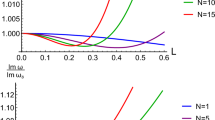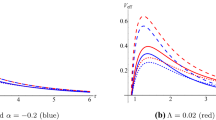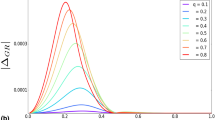Abstract
After a long wait, gravitational wave astronomy has finally begun. Binary black hole mergers are being detected by LIGO and Virgo, and theorists are starting to receive a wealth of data to be analyzed. At this point, we can at long last begin to test alternative theories of gravity and different models of compact objects. One powerful tool to do this is the perturbative analysis of background spacetimes. The objective of this brief review is to introduce the notion and analysis of black hole quasinormal modes, starting from the linear perturbation theory and including a brief discussion of numerical methods and astrophysical implications in the gravitational wave signals recently detected. With these basic ingredients, more sophisticated analyses and applications are possible.
Similar content being viewed by others
Notes
The fully nonlinear stability analysis of a spacetime is a much more complicated affair. So far, physicists have only succeeded to show that the Minkowski spacetime is stable (clearly a not so exciting result from the astrophysical point of view).
One could be tempted to say that \(V^{\text {axial}}_{\ell }\) also has a zero at r = 6M/[ℓ(ℓ + 1)]. However, this is not true: the largest possible value of r (which will be given by ℓ = 2) is r = m, that is, inside the event horizon of the black hole!
Several challenges still have to be overcome. These conjectures lack universality when we consider black holes spactimes with electrical charge, that are non-asymptotically flat or in extra dimensions [16]. An extension to the realm of greybody factors could provide a more direct route to a microscopic interpretation [17].
And this is not the whole story: neutron stars will have different families of quasinormal modes, which will correspond to different restoring forces, like the pressure of the fluid, the buoyancy, the Coriolis force (for rotating stars), etc. Maybe now you will believe what I said in the beginning: black holes are simple!
Note, however, that the still large uncertainties in our knowledge of the mass and angular momentum of the resultant black hole do not currently allow us to completely discard some alternative theories of gravity [23].
References
B.P. Abbott et al., Phys. Rev. Lett. 116, 061102 (2016). https://doi.org/10.1103/PhysRevLett.116.061102
B.P. Abbott et al., Phys. Rev. Lett. 116, 241103 (2016). https://doi.org/10.1103/PhysRevLett.116.241103
B.P. Abbott et al., Phys. Rev. Lett. 118, 221101 (2017). https://doi.org/10.1103/PhysRevLett.118.221101
B.P. Abbott et al., Phys. Rev. Lett. 119, 141101 (2017). https://doi.org/10.1103/PhysRevLett.119.141101
K.D. Kokkotas, B.G. Schmidt, Liv. Rev. Relativ. 2, 2 (1999). https://doi.org/10.12942/lrr-1999-2
H.P. Nollert, Class. Quant. Grav. 16, R159 (1999). https://doi.org/10.1088/0264-9381/16/12/201
R.A. Konoplya, A. Zhidenko, Rev. Mod. Phys. 83, 793 (2011). https://doi.org/10.1103/RevModPhys.83.793
T. Regge, J.A. Wheeler, Phys. Rev. 108, 1063 (1957). https://doi.org/10.1103/PhysRev.108.1063
F.J. Zerilli, Phys. Rev. D 2, 2141 (1970). https://doi.org/10.1103/PhysRevD.2.2141
S. Chandrasekhar, The Mathematical Theory of Black Holes (Oxford University Press, New York, 1992)
V. Ferrari, B. Mashhoon, Phys. Rev. D. 30, 295 (1984). https://doi.org/10.1103/PhysRevD.30.295
L. Motl, Adv. Theor. Math. Phys. 6, 1135 (2003)
J.D. Bekenstein, V.F. Mukhanov, Phys. Lett. B. 360, 7 (1995). https://doi.org/10.1016/0370-2693(95)01148-J
S. Hod, Phys. Rev. Lett. 81, 4293 (1998). https://doi.org/10.1103/PhysRevLett.81.4293
M. Maggiore, Phys. Rev. Lett. 100(14), 141301 (2008). https://doi.org/10.1103/PhysRevLett.100.141301
J. Natario, R. Schiappa, Adv. Theor. Math. Phys. 8(6), 1001 (2004). https://doi.org/10.4310/ATMP.2004.v8.n6.a4
T. Harmark, J. Natario, R. Schiappa, Adv. Theor. Math. Phys. 14(3), 727 (2010). https://doi.org/10.4310/ATMP.2010.v14.n3.a1
C. Chirenti, A. Saa, J. Skakala, Phys. Rev. D. 87(4), 044034 (2013). https://doi.org/10.1103/PhysRevD.87.044034
C. Chirenti, P.R. Silveira, O.D. Aguiar, Int. J. Mod. Phys. Conf. Ser. 18, 48 (2012). https://doi.org/10.1142/S2010194512008185
S.A. Teukolsky, Phys. Rev. Lett. 29, 1114 (1972). https://doi.org/10.1103/PhysRevLett.29.1114
B.P. Abbott et al., Phys. Rev. Lett. 116, 221101 (2016). https://doi.org/10.1103/PhysRevLett.116.221101
V. Cardoso, E. Franzin, P. Pani, Phys. Rev. Lett. 116(17), 171101 (2016). https://doi.org/10.1103/PhysRevLett.117.089902, https://doi.org/10.1103/PhysRevLett.116.171101 [Erratum: Phys. Rev. Lett. 117(8), 089902 (2016)]
R. Konoplya, A. Zhidenko, Phys. Lett. B. 756, 350 (2016). https://doi.org/10.1016/j.physletb.2016.03.044
P.O. Mazur, E. Mottola, Proc. Nat. Acad. Sci. 101, 9545 (2004). https://doi.org/10.1073/pnas.0402717101
C.B.M.H. Chirenti, L. Rezzolla, Class. Quant. Grav. 24, 4191 (2007). https://doi.org/10.1088/0264-9381/24/16/013
C. Chirenti, L. Rezzolla, Phys. Rev. D. 94(8), 084016 (2016). https://doi.org/10.1103/PhysRevD.94.084016
B.P. Abbott, other, Phys. Rev. Lett. 119, 161101 (2017). https://doi.org/10.1103/PhysRevLett.119.161101
Acknowledgements
This brief review is based on the lecture notes I prepared for a short course presented in the XVI Brazilian School of Cosmology and Gravitation (BSCG) held at the Brazilian Center for Physical Research (CBPF) in July 2017. I would like to thank Prof. Mario Novello for the invitation to participate in the XVI BSCG, the other lecturers and the students for a week of very interesting conversations and interactions, and CBPF for the financial support during my stay in Rio.
Author information
Authors and Affiliations
Corresponding author
Rights and permissions
About this article
Cite this article
Chirenti, C. Black Hole Quasinormal Modes in the Era of LIGO. Braz J Phys 48, 102–109 (2018). https://doi.org/10.1007/s13538-017-0543-7
Received:
Published:
Issue Date:
DOI: https://doi.org/10.1007/s13538-017-0543-7




